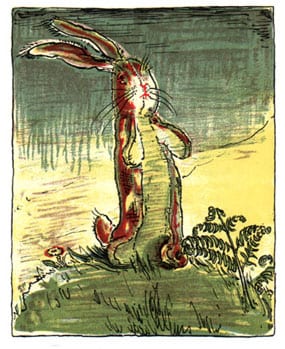Getting Real
Or, the Velveteen Rabbit as a Commentary on an Ancient Zen Koan
There’s a Facebook meme going around that purports to be an analysis of cockroach opinion. Apparently, they see the future looking pretty good. At least for cockroaches.
As far as human beings go, we seem a textbook example of success carrying within itself the seeds of its own destruction. Over population and ecological catastrophe following our human excesses seem to go hand in hand, and with that hand in hand, on over the cliff. So, the prospect for humans, is maybe a bit less optimistic.
And with that I find myself thinking about an old Zen koan. I’m sorry, things remind me of koans: those old Zen stories that purport to point to the deepest truths of our existence. When properly engaged they can help us see through the stories we create that are not always helpful. Instead they point into the deeper matters of life and death, and invite us to occupy those spaces.
This one comes from the early Twelfth century Chinese anthology of Zen stories, the Blue Cliff Record. It’s the sixth story in the collection and it’s all about awakening, our stumbling into the real. As we consider our lives, as we look at how hard things can be, both in our individual lives and communally, we need to see as clearly as we humans can.
We need to find that illusive thing that is sometimes called “the real.” In this Zen story we are told:
Yunmen asked his assembly, “I don’t ask you about before the 15th of the month. Tell me something about after the 15th.” No one spoke, so he responded himself, “Every day is a good day.”
This is a particularly important koan in my life. I believe I’ve mentioned it once or twice before. And, I suspect I’ll return to it again.
To remind you, this isn’t a non sequitur. The 15th is the time of the full moon and is a common metaphor in East Asia for the moment of awakening. And awakening is our stirring from the slumbers of our certainties, the ideas and beliefs that prevent us from seeing what’s actually going on, and, from there into the real.
So, it probably doesn’t hurt to note that Yunmen lived in harsh, politically unstable times, where armies were on the march and famine and hunger and danger were the common currency of the day. The possibility of bad endings was more along the line of a probability. So, it would be very hard to find the phrase “every day is a good day” as meaning “don’t worry, be happy.” This good day carries with it the possibility if not the probability of ending very badly. It’s all about the real.
The real.
Within the great mix of life, I found myself thinking of Margery Williams lovely and in some ways sad story, the Velveteen Rabbit: Or, How Toys Become Real. And specifically of one passage.
“What is REAL?” asked the Rabbit one day, when they were lying side by side near the nursery fender, before Nana came to tidy the room. “Does it mean having things that buzz inside you and a stick-out handle?”
“Real isn’t how you are made,” said the Skin Horse. “It’s a thing that happens to you. When a child loves you for a long, long time, not just to play with, but Really loves you, then you become Real.”
“Does it hurt?” asked the Rabbit.
“Sometimes,” said the Skin Horse, for he was always truthful. “When you are Real you don’t mind being hurt.”
“Does it happen all at once, like being wound up,” he asked, “or bit by bit?”
“It doesn’t happen all at once,” said the Skin Horse. “You become. It takes a long time. That’s why it doesn’t happen often to people who break easily, or have sharp edges, or who have to be carefully kept.
Generally, by the time you are Real, most of your hair has been loved off, and your eyes drop out and you get all loose in the joints and very shabby. But these things don’t matter at all, because once you are Real you can’t be ugly, except to people who don’t understand.”
Me, I believe that koan from Twelfth century China and this novel from early Twentieth century America fit together like a box and its lid.
A little about the author. Margery Winifred Williams was born in London in 1881. She was the youngest of four children. Her father Robert was a British barrister, as well as a fellow at Merton College, Oxford, where he taught classics. So, a person of many parts. Her mother Florence was the daughter of an Oxford librarian and seeped in that traditional intellectual culture. However, Margery’s father died when she was seven. And not long after her eldest sister died, as well. Everything was disrupted.
Three years later her mother took the surviving children on an extended visit to America. Margery attended school in New York and later Pennsylvania. She would carry the marks of this Anglo American experience throughout her life.
Her father seemed to haunt her. She credits his love of literature and his untimely death as profound markers for her. And her writing would always show a sensitivity to the fragility of life and the reality of death in ways unusual for children’s books.
Margery’s first novel, the Late Returning was published when she was nineteen, not long after she and her mother returned to England. At twenty-one she married Francesco Bianco, an Italian national and rare book dealer. They had two children, Francesco Marco and Pamela. Pamela grew up to be an artist & illustrator. The family traveled and settled for varying amounts of time in England and France and Italy and then back to England before finally settling in the United States. From there the family’s home base would remain America. Margery died in New York in 1944.
This reflection is all about spirituality, that which gives us life, and there are important threads in Margery’s spiritual life. The family had been raised Anglican, but in the turmoil following her father and sister’s death their mother converted to Catholicism and brought the children with her. In fact part of Margery’s upbringing would include two years in a convent school. So, classics and Catholicism are part of her deep background.
Actually, she credits the poet Walter John de la Mare as her “spiritual mentor.” De la Mare’s obituary hints at the substance of his spirituality, declaring his “poetry and prose have a kinship with mystical literature in being unconditioned by historical time and his verse in particular belongs to that rare and timeless strain in literature…” We certainly can see this, as well, when we think of the deep currents informing that passage from the Velveteen Rabbit.
A passion for the imaginal life, the dream worlds. Oh. And. It probably didn’t hurt that Margery once mentioned how her mother always treated her dolls and stuffed animals as if they were real. Everything, however, small and large are marked by the realities of life, especially change, especially death. Another distinctive feature Williams brought to the Velveteen Rabbit as well as the rest of her twenty children’s books, was her profound respect for children, seeing them as sensible as adults, lacking only experience.
So, within it all I’m finding Williams’ vision a sort of a spirituality of magical realism, which I’m using to mean where the earthly life and dream meet. This space, where we let loose of our certainties, and the realities of life play out in ways we can never fully anticipate, that’s the real.
It is, in fact, the only genuine real.
Which returns us to koans. Koans. Assertions about reality and an invitation. And so. Like with how work with a koan, first we throw the backstory away. Good to know it. But, now we let it go. And then just looking for the nugget of truest true within the words as they present. There are a number in that passage.
The greatest of which is “What is real?” It’s a first question for anyone who dreams. We clearly live in multiple worlds. But, which, if any, is true? Life. Hurt. Loss. Death. Love. These words arise from the heart of our existence. And the human quest becomes one of digging into these various worlds of perception and interpretation, seeking an encounter that might bring the worlds together, might lead to some great reconciliation of heart and world.
But, immediately, with the very next draw of breath we’re invited to look a bit deeper than the surface of things. Although, I’ve been warned, we’ve been warned by our teachers on the great intimate way that the surface of things is it, too. But, we do need different eyes, the eyes of imagination and of dream, if we want fully to encounter the real.
Here we find the call to full engagement. We are not invited to turn away. The dream realms, the real ones, the dreams that speak truth, do not take us to some far away land. Rather we must engage the world as a child playing with us. We must engage the world, this world, the one that plays rough, that pulls and tears and, and, well, and loves us.
Love here is attention. Love here is presence. It is the magic within the magic.
And it is hard. And it takes time. In the Zen traditions we make a lot of moments of insight. And, they are important. I think a bit think a bit more important than in Margery Williams anecdote. But, she hits the more important note. Whatever our momentary experiences, it is the aggregate that makes us who we are. We are not things. We are processes. We are waves. We are dancing air.
Those of us who are impatient about this project are going to be hurt. Well, okay, we’re all going to be hurt. Hurt just comes with the territory. Hurt is a big part of the territory. But the invitation is into each day and each moment, and then to let them pile upon each other, for as long as they do. Graces come, but they are not shortcuts taking us away from the project.
So, the hurt and the joy, they become facets of a same truth. Here the discoveries of the heart and the life we live are found as one thing. Here, the sadnesses of our lives and the consolations of our lives are each of them facets of a single life.
And Margery, well she sings the deeper truths of this to us, all of us, wherever we are. Young and excited and anxious? She opens the way. Or, perhaps, we have grown old, as the joints hurt, as the hair thins or is lost, as our eyesight, the part that is solely the eye of the flesh, begins to fail? Here, too, she calls us to how we find ourselves the repository of a world of dreams.
And within those dreams the world becomes real.
The real. Is. Eternity and a moment.
And, of course, then what?
Here we are. There are still bills to pay. Things to do. And. You are dying. I am dying. Our species is dying. The world is dying.
Getting real is not missing any of those things. The Skin Horse understood. It’s the other side of the 15th. It’s the call of the rainbow. It is, well, dear ones, it is our very lives.
Just this. Attend. Love. Just this.













